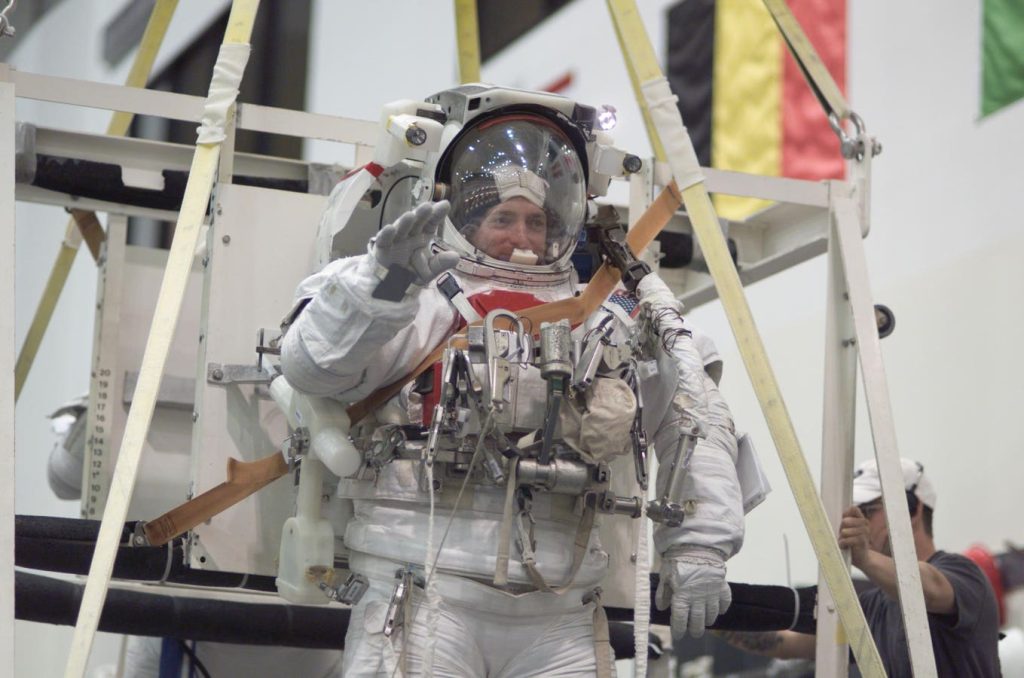If Mark Kelly, the Space Shuttle pilot who played a pivotal role in assembling the International Space Station, is catapulted into the White House as Vice President, he could quickly help reverse the death sentence that NASA’s current leaders have placed on the ISS.
Now a widely popular U.S. senator and potential running mate of Kamala Harris, Kelly spent the first decade of the new millennium ferrying European and Japanese modules to the Station – and guiding gigantic robotic builders to put the ISS together – all while the outpost was circling the planet at 17,000 miles per hour.
The space hero – recently inducted into the pantheon of the greatest American astronauts – is likely part of a contingent of ISS spacefarers who back saving the orbiting icon from NASA’s death decree by boosting it into a higher orbit and transforming it into an eternal monument to human ingenuity, says Rick Tumlinson, a torchbearer in the “Save Our Station,” or SOS movement.
NASA recently announced it would commission SpaceX to develop a terminator spacecraft to crash the $100-billion Station into a Styx-like underworld in the Antarctic seas, but blowback to that plan has been swift.
The onetime directors of the European Space Agency and of NASA who co-directed the construction of the Station are now calling for it to be protected as an unparalleled treasure house of technology – a masterwork of human civilization that could be propelled above the high-traffic zone of low Earth orbit that it now navigates.
Jean-Jacques Dordain, ESA’s Director General when the ISS was being built, told me in an interview that his American counterpart, former NASA Administrator Michael Griffin, reached out to him to co-write a worldwide appeal calling for a new future for the ISS. The twin aerospace wizards have been lauded across the globe for their engineering of the celestial beacon.
Tumlinson, whose venture capital firm SpaceFund has invested in some of the independent space stations slated to replace the ISS in low Earth orbit, has overseen parallel SOS appeals – from contacting Members of Congress to safeguard the Station to seeking out onetime ISS astronauts to join the movement.
He predicts Senator Kelly, who combines the power of the Senate with the allegiance of the astronauts to the International Space Station, could turn the tide in the campaign to send the ISS into an Elysian orbit.
“I love the idea that we might have an astronaut as VP,” Tumlinson told me in an interview. “As an astronaut he will have a visceral understanding of how important it is” to safeguard the Station for generations into the future.
As Vice President, Kelly would almost certainly be appointed to head the powerful National Space Council, the post that Harris has mastered over the past three years.
The head of the Space Council collaborates with the Secretary of Defense, the National Security Advisor and the Chairman of the Joint Chiefs of Staff to safeguard American space operations and to counter any challenges posed by rivals – including Russia’s anti-satellite missiles and nuclear-armed spacecraft – across the world stage and in orbit.
Kelly’s background as a Naval test pilot – recognised with a Distinguished Flying Cross – and as Shuttle commander make him the ideal candidate to head the National Space Council, Tumlinson says. And from that post Kelly could orchestrate a campaign to protect the ISS.
Professor Jack Beard, formerly a high-ranking counsel at the Department of Defense who is now director of the Space, Cyber & National Security Law Program at the University of Nebraska College of Law, says Senator Kelly would make “a perfect new head of the National Space Council.”
Kelly’s experience as a co-builder of the Space Station, and now leader on the Senate’s Armed Services Committee, provide an excellent foundation for him to head the Council and direct its space defense operations, Professor Beard told me in an interview.
With his post on the high-power Senate committee, Kelly would have frequent contact with the leaders of the U.S. Space Force, along with intricate knowledge of the Force’s operations, Beard adds, and could therefore hit the ground running on Day 1 overseeing the Space Council.
Kelly launched the first stage of his Space Odyssey in 2001, when he shuttled the European Raffaello Module to the Station. A decade later, while aboard the ISS, he was on the receiving end of the Pope’s first-ever call from Earth to orbit.
Pope Benedict praised Kelly and his crew mates, telling them: “You are our representatives – spearheading humanity’s exploration of new spaces and possibilities for our future, going beyond the limitations of our everyday existence.”
Pope Benedict then singled out Kelly with a question: “You fly over different continents and nations several times a day … When you are contemplating the Earth from up there, do you ever wonder about the way nations and people live together down here, or about how science can contribute to the cause of peace?”
“We fly over most of the world and you don’t see borders, but at the same time we realize that people fight with each other,” Kelly replied, while adding he hoped technological advances would ultimately bring peace on Earth.
Read the full article here










